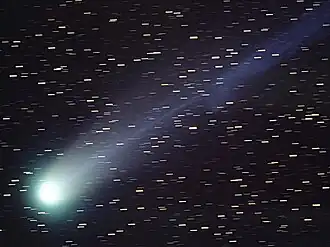C/1937 P1 (Hubble)
| Discovery[1][2] | |
|---|---|
| Discovered by | Edwin Hubble |
| Discovery site | Mount Wilson Obs. |
| Discovery date | 4 August 1937 |
| Designations | |
| 1937g[3] 1936 V | |
| Orbital characteristics[4] | |
| Epoch | 8 November 1936 (JD 2428480.5) |
| Observation arc | 85 days |
| Number of observations | 58 |
| Aphelion | 140.125 AU |
| Perihelion | 1.9536 AU |
| Semi-major axis | 71.039 AU |
| Eccentricity | 0.9725 |
| Orbital period | 599 years |
| Inclination | 11.581° |
| 97.796° | |
| Argument of periapsis | 147.49° |
| Last perihelion | 14 November 1936 |
| TJupiter | 1.759 |
| Physical characteristics | |
| 13.5 (1937 apparition) | |
Comet Hubble, formally designated C/1937 P1, is the first and only comet discovered by astronomer Edwin Hubble. The comet was already on its outbound flight when it was first spotted in August 1937 as a magnitude 13.5 object in the constellation Sagittarius.[1][5] It is the fourth comet discovered in 1937.[6]
References
- ^ a b G. van Biesbroeck (October 1937). "Comet Notes". Popular Astronomy. 45: 437–438. Bibcode:1937PA.....45..437V.
- ^ E. Strömgren (5 August 1937). "New Comet". Central Bureau for Astronomical Telegrams. 673.
- ^ "Comet Names and Designations". International Comet Quarterly. Retrieved 9 December 2024.
- ^ "C/1937 P1 (Hubble) – JPL Small-Body Database Browser". ssd.jpl.nasa.gov. Jet Propulsion Laboratory. Retrieved 30 October 2024.
- ^ A. Pryzybylski. "Definitive Orbit of Comet 1937 g (Hubble)". Journal des Observateurs. 35: 113–120. Bibcode:1952JO.....35..113P.
- ^ F. L. Whipple (September 1937). "The Comets of 1937". The Scientific Monthly. 45 (3): 281–284. JSTOR 16438.
External links
- C/1937 P1 at the JPL Small-Body Database

.png)